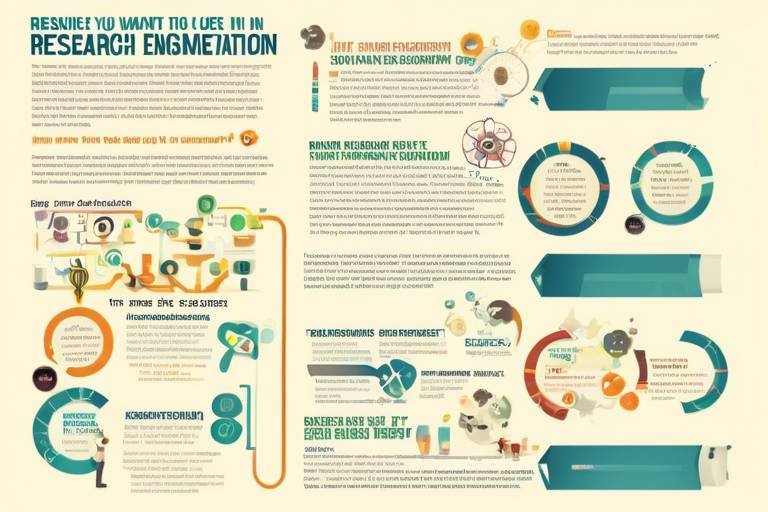Innovations in Teaching Research Methods - Engaging Students
In today's fast-paced academic environment, teaching research methods effectively is more crucial than ever. With the advent of new technologies and innovative teaching strategies, educators are continually searching for ways to make the learning process not only effective but also engaging for students. Research methods can often seem daunting, filled with complex theories and intricate processes. However, by incorporating innovative techniques, we can transform this perception. The goal is to create an atmosphere where students feel empowered, curious, and excited about the research process.
One of the primary challenges educators face is student disengagement. Traditional lecture-based approaches often fail to captivate students' attention, leading to a lack of interest in the subject matter. But what if we could turn this around? Imagine a classroom where students are not just passive recipients of information but active participants in their learning journey. This is where active learning strategies come into play. By fostering an environment of collaboration, discussion, and hands-on activities, students can develop a deeper understanding of research methods.
Moreover, the integration of technology into teaching research methods can significantly enhance the learning experience. We live in an era where technology is ubiquitous, and students are more tech-savvy than ever. Utilizing tools such as online collaboration platforms and data analysis software can make learning more interactive and relevant. For instance, students can work together on research projects using platforms like Google Docs or Miro, which not only promotes teamwork but also enhances their communication skills. Additionally, incorporating video conferencing applications allows for real-time discussions, breaking down geographical barriers and enabling students to connect with experts from around the world.
But let's not stop there! Gamification is another exciting innovation that can revolutionize how research methods are taught. By incorporating game design elements into the learning process, we can boost motivation and make learning more enjoyable. Imagine students competing in research challenges or earning badges for completing specific tasks. This approach not only makes learning fun but also encourages a deeper commitment to mastering research skills.
Project-based learning is yet another powerful strategy that encourages students to apply their knowledge in real-world scenarios. This method allows students to engage with research methods in a practical context, enhancing their understanding and retention of the material. By connecting research methods to current events or case studies, students can see the relevance of their studies and how they apply to the world around them.
In conclusion, the innovations in teaching research methods are numerous and varied. By embracing active learning, integrating technology, gamifying education, and employing project-based learning, educators can create a dynamic and engaging learning environment. The ultimate goal is to inspire students to become not just consumers of information but active contributors to the world of research. As we continue to explore these innovative techniques, we can look forward to a future where research methods are not just learned but truly understood and appreciated.
- What are active learning strategies? Active learning strategies involve techniques that encourage student participation and critical thinking, such as group discussions, hands-on activities, and collaborative projects.
- How can technology enhance the teaching of research methods? Technology can provide interactive learning experiences through tools like online collaboration platforms, data analysis software, and video conferencing applications.
- What is gamification in education? Gamification involves incorporating game-like elements into the learning process to increase motivation and engagement, such as challenges, rewards, and competition.
- What are the benefits of project-based learning? Project-based learning allows students to apply their knowledge in real-world contexts, enhancing understanding and retention while fostering critical thinking and collaboration skills.

Active Learning Strategies
Active learning strategies are game-changers in the realm of education, especially when it comes to teaching research methods. Imagine a classroom where students are not just passive recipients of information, but rather active participants in their own learning journey. This shift from traditional lecturing to engaging, hands-on experiences can make a world of difference in how students perceive and understand research methods. Why is this so important? Because when students are actively involved, they are more likely to retain information and develop critical thinking skills that are essential in today’s data-driven world.
One effective way to implement active learning is through think-pair-share activities. In this method, students first think about a question related to research methods, then pair up with a partner to discuss their thoughts before sharing their insights with the larger group. This not only encourages participation but also fosters a sense of community in the classroom. Another innovative approach is the use of case studies. By analyzing real-world scenarios, students can apply theoretical concepts to practical situations, making the learning experience much more relevant and impactful.
Moreover, incorporating role-playing exercises can also enhance engagement. For instance, students could take on the roles of researchers, participants, or even critics in a mock research project. This experiential learning approach allows them to step into different perspectives, deepening their understanding of the research process. Additionally, using peer teaching strategies can be incredibly effective. When students teach their peers about specific research methods or findings, they reinforce their own knowledge while also boosting their communication skills.
To further illustrate the effectiveness of these strategies, consider the following table that outlines several active learning techniques along with their benefits:
| Active Learning Technique | Benefits |
|---|---|
| Think-Pair-Share | Encourages critical thinking and collaboration among students. |
| Case Studies | Connects theory to practice, enhancing relevance and application. |
| Role-Playing | Promotes empathy and understanding of different research perspectives. |
| Peer Teaching | Reinforces knowledge and improves communication skills. |
Incorporating these active learning strategies into research methods courses not only makes the subject matter more engaging but also equips students with the necessary skills to navigate their academic and professional futures. The goal is to create an environment where students feel empowered to explore, question, and apply their knowledge in meaningful ways. As educators, embracing these innovative techniques can lead to a more dynamic and effective learning experience for everyone involved.

Technology Integration
In today's fast-paced educational landscape, integrating technology into teaching research methods is no longer just an option; it’s a necessity. With the advent of digital tools, educators have a unique opportunity to transform traditional teaching into an interactive and engaging experience. Imagine walking into a classroom where students are not just passive recipients of information but active participants in their learning journey, utilizing cutting-edge technology to enhance their understanding of research methodologies. This transformation can lead to a deeper comprehension of complex concepts and, ultimately, better research outcomes.
One of the most effective ways to integrate technology is through the use of various interactive tools and platforms. These technologies can facilitate not only the acquisition of knowledge but also the application of skills in real-time. For instance, platforms like Google Scholar and Mendeley allow students to access a wealth of academic resources and manage their references efficiently. When students can effortlessly navigate these tools, they are more likely to engage with their research projects enthusiastically. Furthermore, the use of virtual labs and simulations can provide students with hands-on experience, making abstract concepts more concrete and relatable.
Moreover, incorporating online collaboration tools into research methods courses can significantly enhance student engagement. Platforms like Slack, Trello, and Microsoft Teams promote teamwork and communication, allowing students to collaborate effectively on research projects regardless of their physical location. By working together in a digital environment, students develop essential skills such as communication, problem-solving, and critical thinking. These tools not only foster a sense of community among students but also prepare them for the collaborative nature of real-world research.
When students use online collaboration tools, they can experience a dynamic learning environment. For example, they can share documents, provide feedback, and brainstorm ideas in real-time. This collaborative process can be crucial for developing research proposals and conducting literature reviews. Utilizing these tools can lead to improved outcomes, as students learn from each other and build on their collective knowledge. In this way, technology becomes a bridge that connects students and enhances their learning experience.
Another remarkable aspect of technology integration is the use of video conferencing applications such as Zoom or Microsoft Teams. These platforms have revolutionized how we conduct discussions and presentations, allowing students to engage in real-time conversations with peers and instructors from anywhere in the world. Imagine a scenario where students can present their research findings to a panel of experts or collaborate with international students on a joint project. This not only enriches their learning experience but also exposes them to diverse perspectives and methodologies.
Furthermore, the incorporation of data analysis software into research methods courses provides students with invaluable hands-on experience. Programs like SPSS, R, and Tableau allow students to work with real datasets, analyze trends, and visualize their findings. This practical application of research methods makes learning more relevant and engaging. When students can see the direct impact of their analyses on real-world issues, their motivation to learn increases significantly. It’s like giving them the keys to a treasure chest of data, unlocking insights that can lead to meaningful discoveries.
In conclusion, technology integration in teaching research methods is a game-changer. By utilizing a variety of digital tools, educators can create a more engaging, interactive, and practical learning environment. This not only enhances students' understanding of research methodologies but also prepares them for the demands of a technology-driven world. Embracing these innovations is essential for fostering a generation of skilled researchers who are ready to tackle the challenges of tomorrow.
- How can technology improve student engagement in research methods?
Technology provides interactive tools that facilitate collaboration, real-time feedback, and access to a wealth of resources, making learning more engaging. - What are some effective online collaboration tools?
Popular tools include Slack, Trello, and Microsoft Teams, which allow students to communicate and work together on projects seamlessly. - Why is hands-on experience important in learning research methods?
Hands-on experience helps students apply theoretical knowledge to real-world scenarios, enhancing their understanding and retention of research concepts.

Online Collaboration Tools
In today’s fast-paced academic environment, have become indispensable for students learning research methods. These tools not only enhance communication but also foster a sense of community among students, making the often daunting task of research feel more manageable and engaging. Imagine a virtual classroom where students from different corners of the globe can come together, share ideas, and work on projects as if they were sitting side by side. Isn't that an exciting prospect?
One of the most significant advantages of using online collaboration tools is the ability to promote teamwork. Students can easily collaborate on research projects, share resources, and provide feedback to one another in real-time. This collaborative environment encourages critical thinking and creativity, as students are exposed to diverse perspectives and approaches. Platforms like Google Docs, Microsoft Teams, and Slack offer functionalities that allow students to edit documents simultaneously, hold discussions, and even organize their thoughts using shared boards.
Moreover, these tools often come equipped with features that facilitate seamless communication. For instance, video conferencing applications like Zoom or Microsoft Teams enable students to engage in real-time discussions, making it feel as though they are physically present in the same room. This can significantly enhance the learning experience, as students can ask questions, clarify doubts, and brainstorm ideas on the spot. Can you imagine the excitement of presenting your findings to peers who are just as invested in the project as you are?
Additionally, online collaboration tools can also help in organizing research tasks efficiently. With project management applications like Trello or Asana, students can create boards to track their progress, assign tasks to team members, and set deadlines. This structured approach not only keeps everyone accountable but also teaches valuable skills in project management—an essential aspect of conducting effective research.
To illustrate the effectiveness of these tools, consider the following table that compares popular online collaboration platforms:
| Tool | Features | Best For |
|---|---|---|
| Google Docs | Real-time editing, commenting, and chat | Document collaboration |
| Slack | Channels for discussions, file sharing | Team communication |
| Trello | Task management, visual project tracking | Project organization |
| Zoom | Video conferencing, screen sharing | Virtual meetings |
In conclusion, integrating online collaboration tools into the teaching of research methods not only enhances student engagement but also equips them with essential skills for their future careers. The ability to collaborate effectively is a critical component of research, and these tools provide a fantastic way for students to experience this firsthand. By embracing technology in the classroom, educators can create a dynamic and interactive learning environment that prepares students for the challenges of the real world.
- What are online collaboration tools?
Online collaboration tools are digital platforms that enable users to work together on projects, share information, and communicate in real-time, regardless of their physical location.
- How can these tools enhance learning?
They enhance learning by promoting teamwork, improving communication, and providing a structured environment for project management, which helps students engage more deeply with the material.
- Are there any costs associated with these tools?
Many online collaboration tools offer free versions with essential features, while advanced functionalities may require a subscription or one-time payment.

Video Conferencing Applications
In today's fast-paced educational landscape, have emerged as powerful tools for enhancing the teaching of research methods. These platforms allow instructors and students to engage in real-time discussions, fostering a more interactive learning environment. Imagine being able to connect with peers and experts from around the globe, all from the comfort of your classroom or home. This is the magic that video conferencing brings to the table!
One of the standout features of these applications is their ability to bridge geographical gaps. Students can participate in live lectures, workshops, and collaborative projects without being restricted by location. This not only broadens their learning opportunities but also enriches their understanding of diverse perspectives in research. For instance, a student in New York can easily collaborate with a classmate in Tokyo, sharing insights and methodologies that may differ significantly across cultures.
Moreover, video conferencing tools often come equipped with features that enhance the learning experience. Features such as screen sharing, breakout rooms, and recording capabilities allow for a more dynamic and engaging classroom atmosphere. Instructors can present complex data visually, making it easier for students to grasp intricate research concepts. Breakout rooms can be used for group discussions, enabling students to delve deeper into specific topics while fostering teamwork and communication skills.
To illustrate the impact of these applications, let's take a look at some of the most popular video conferencing tools that are making waves in education:
| Application | Features | Benefits |
|---|---|---|
| Zoom | Breakout rooms, screen sharing, recording | Flexible group work, easy access to recorded sessions |
| Microsoft Teams | Integrated with Office 365, file sharing | Seamless collaboration on documents |
| Google Meet | Real-time captions, integration with Google Workspace | Accessibility features, easy scheduling |
These applications not only facilitate learning but also encourage students to develop essential skills for the modern workforce. By engaging in virtual discussions, students learn to articulate their ideas clearly and respond to feedback constructively. This is crucial in the realm of research, where collaboration and communication are key to successful outcomes.
In conclusion, the integration of video conferencing applications into the teaching of research methods is a game changer. It not only enhances student engagement but also prepares them for a world that increasingly values remote collaboration. As educators, embracing these technologies can lead to more effective teaching strategies and a richer learning experience for students.
- How can video conferencing improve student engagement? Video conferencing allows for real-time interaction, making discussions more dynamic and encouraging student participation.
- What are some challenges of using video conferencing in education? Technical issues, such as connectivity problems, can arise, and some students may feel less comfortable speaking in a virtual setting.
- Are there specific platforms recommended for teaching research methods? Yes, platforms like Zoom, Microsoft Teams, and Google Meet are highly recommended due to their collaborative features and ease of use.

Data Analysis Software
In today's data-driven world, plays a pivotal role in research methods education. These tools not only provide students with the opportunity to work with real datasets but also enhance their analytical skills, making learning more relevant and applicable. Imagine a classroom where students are not just passive recipients of information but active participants, diving into data like detectives solving a mystery. This is the power of integrating data analysis software into the curriculum.
One of the most significant advantages of using data analysis software is the hands-on experience it offers. Students can manipulate data, run statistical analyses, and visualize results, which deepens their understanding of research methodologies. For instance, software like SPSS, R, and Excel can be utilized to teach students how to interpret data and draw meaningful conclusions. By engaging with these tools, students learn to appreciate the intricacies of data collection, analysis, and interpretation.
Furthermore, the incorporation of data analysis software fosters a more interactive and collaborative learning environment. Students can work in groups to analyze datasets, encouraging teamwork and communication. This collaborative effort can be enhanced by using online platforms that allow for real-time data sharing and discussion. For example, tools like Google Sheets or Tableau can be utilized to visualize data trends and patterns, making it easier for students to grasp complex concepts. Imagine students presenting their findings in class, using vibrant graphs and charts that tell a story. It transforms the learning experience from mundane lectures to dynamic presentations.
To illustrate the impact of data analysis software, consider the following table that outlines some popular tools and their features:
| Software | Key Features | Best For |
|---|---|---|
| SPSS | Statistical analysis, data management, and predictive analytics | Social sciences |
| R | Statistical computing, data visualization, and advanced analytics | Statistical programming |
| Excel | Data organization, basic statistical functions, and chart creation | General data analysis |
| Tableau | Data visualization and business intelligence | Visual data representation |
Incorporating these tools into research methods courses not only equips students with essential skills but also prepares them for the demands of the workforce. Employers increasingly seek individuals who are proficient in data analysis, making these skills invaluable. By using data analysis software in the classroom, educators can bridge the gap between academic learning and real-world application, ensuring that students are well-prepared for their future careers.

Gamification of Learning
Imagine walking into a classroom where learning feels less like a chore and more like an exciting adventure. That's the magic of gamification! By incorporating game design elements into educational settings, we can transform traditional teaching methods into engaging experiences that captivate students' attention. But what exactly does this mean for teaching research methods? Well, it opens up a world of possibilities!
Gamification can take many forms in the context of research methods. For instance, educators can create interactive quizzes that allow students to test their knowledge in a fun way. Instead of simply memorizing facts, students can earn points and badges for completing challenges, which fosters a sense of achievement. This competitive spirit can motivate students to dive deeper into the subject matter, making them more invested in their learning.
One effective strategy is to design a simulation game where students must conduct research to solve a mystery or complete a project. For example, students could be tasked with investigating a fictional crime scene, gathering data, and analyzing evidence to present their findings. This not only makes learning enjoyable but also helps students understand the research process in a real-world context.
Moreover, the use of leaderboards can add an extra layer of excitement. By displaying the top performers in the class, students may feel encouraged to improve their skills and knowledge. But it's essential to ensure that this competition remains friendly and supportive, promoting collaboration rather than discouragement.
Additionally, gamification can facilitate peer learning. Students can work in teams to complete research projects, sharing ideas and strategies while competing against other groups. This not only enhances their understanding of research methods but also builds essential teamwork and communication skills.
To illustrate the potential of gamification, consider the following table that outlines some popular gamification techniques and their benefits:
| Gamification Technique | Description | Benefits |
|---|---|---|
| Point Systems | Students earn points for completing tasks and participating. | Encourages participation and rewards effort. |
| Badges and Achievements | Visual representations of accomplishments. | Boosts motivation and provides a sense of achievement. |
| Leaderboards | Displays rankings based on performance. | Fosters healthy competition and engagement. |
| Simulation Games | Realistic scenarios where students apply research methods. | Enhances understanding through practical application. |
In conclusion, gamification is not just a trend; it's a powerful tool that can revolutionize the way research methods are taught. By harnessing the principles of game design, educators can create an environment where students are excited to learn, collaborate, and explore the world of research. So, why not make your classroom a game-changer?
Q: What is gamification?
A: Gamification is the application of game design elements in non-game contexts, such as education, to enhance engagement and motivation.
Q: How can gamification improve learning outcomes?
A: By making learning fun and interactive, gamification encourages students to participate actively, which can lead to better retention of information and a deeper understanding of concepts.
Q: Are there any downsides to gamification?
A: While gamification can be highly effective, it’s important to strike a balance. Overemphasis on competition might discourage some students, so it’s essential to foster a supportive environment.
Q: What tools can be used for gamifying research methods?
A: There are several tools available, such as Kahoot! for quizzes, Classcraft for classroom management, and various simulation software designed for educational purposes.

Project-Based Learning
Project-Based Learning (PBL) is a transformative approach that allows students to immerse themselves in real-world challenges while honing their research skills. Imagine a classroom where students aren't just passive recipients of information, but active explorers of knowledge! This method encourages learners to dive deep into projects that require critical thinking, collaboration, and creativity. It's like giving students a treasure map, where the treasure is the knowledge they gain through hands-on experience.
One of the most significant benefits of PBL is its ability to connect theoretical concepts with practical applications. Instead of memorizing research methods in isolation, students can apply these techniques to solve actual problems, making their learning experience more relevant and impactful. For instance, a project might involve conducting surveys to understand community health issues, allowing students to see firsthand how research methods can drive change.
Incorporating PBL into research methods courses not only enhances engagement but also fosters a sense of ownership among students. When they take the lead on projects, they become more invested in their learning journey. This approach often leads to higher retention rates and a deeper understanding of the material. To illustrate, consider the following key components that make PBL effective:
| Component | Description |
|---|---|
| Real-World Relevance | Projects tackle real issues, making learning meaningful. |
| Collaboration | Students work in teams, enhancing communication and teamwork skills. |
| Critical Thinking | Students analyze and synthesize information to arrive at solutions. |
| Reflection | Students evaluate their work and learning process, promoting growth. |
Moreover, PBL can be enhanced by integrating interdisciplinary projects that draw from various fields of study. For example, a project that investigates environmental sustainability can incorporate elements of science, economics, and social studies. This not only enriches the learning experience but also encourages students to think outside the box and appreciate the interconnectedness of different disciplines.
Finally, the key to successfully implementing PBL in teaching research methods lies in the instructor's ability to facilitate and guide students. Educators should provide support and resources while allowing students the freedom to explore their interests. This balance creates an environment where curiosity flourishes, leading to innovative solutions and a more profound understanding of research methodologies.
- What is Project-Based Learning? - Project-Based Learning is an instructional approach that engages students in exploring real-world problems through hands-on projects.
- How does PBL enhance student engagement? - By connecting learning to real-life scenarios, PBL fosters active participation and a sense of ownership over the learning process.
- Can PBL be applied to any subject? - Yes, PBL can be effectively implemented across various subjects, including research methods, science, humanities, and more.
- What role do teachers play in PBL? - Teachers act as facilitators, guiding students through the project while providing necessary resources and support.

Real-World Applications
When it comes to teaching research methods, one of the most effective ways to engage students is by demonstrating the of what they are learning. Imagine being in a classroom where students are not just memorizing theories and formulas but are actually seeing how these concepts play out in everyday life. This approach not only makes the learning experience more relevant but also ignites a passion for research that can last a lifetime.
To truly grasp the significance of research methods, students should be exposed to current events and case studies that illustrate how these methods are applied in various fields. For instance, consider how a public health crisis, like the COVID-19 pandemic, can serve as a rich case study for students. They can analyze data collection methods, evaluate the effectiveness of different research designs, and even assess the impact of various interventions. This hands-on experience allows students to connect theory with practice, making their learning journey not only informative but also transformative.
Incorporating real-world scenarios into the curriculum can be achieved through various strategies:
- Case Studies: Presenting students with real-life case studies encourages them to apply research methods to analyze situations critically. For example, they could investigate the marketing strategies of a successful startup or evaluate the effectiveness of a new educational program.
- Field Research: Organizing field trips or community projects enables students to gather data firsthand. This could involve surveying local businesses or conducting interviews with community leaders, providing them with invaluable experience that textbooks simply can't offer.
- Guest Speakers: Inviting professionals from various industries to discuss how they utilize research methods in their work can provide students with insights into potential career paths and the practical applications of their studies.
Furthermore, educators can enhance this experience by utilizing multimedia resources such as documentaries and podcasts that showcase research in action. For instance, a documentary about climate change can illustrate the importance of data collection and analysis in environmental studies. By witnessing the impact of research on pressing global issues, students are more likely to appreciate the relevance of what they are learning.
In summary, by linking research methods to real-world applications, educators can create a dynamic learning environment that fosters critical thinking and enhances student engagement. This not only prepares students for academic success but also equips them with the skills necessary to navigate and contribute to the world around them.
Q: Why is it important to teach research methods with real-world applications?
A: Teaching research methods with real-world applications helps students understand the relevance of their studies, enhances critical thinking, and prepares them for practical challenges they may face in their careers.
Q: How can case studies be effectively integrated into the curriculum?
A: Case studies can be integrated by selecting relevant topics, encouraging group discussions, and assigning projects that require students to analyze and present their findings based on real-life scenarios.
Q: What role do guest speakers play in teaching research methods?
A: Guest speakers provide first-hand insights into how research methods are applied in various industries, offering students a glimpse into potential career paths and the practical implications of their studies.

Interdisciplinary Projects
Interdisciplinary projects are like a vibrant tapestry woven from various threads of knowledge, combining insights from multiple fields to create a richer learning experience. When students engage in these projects, they don't just learn research methods in isolation; instead, they see how these methods can be applied across different disciplines. Imagine a student studying environmental science who collaborates with peers from sociology and economics to tackle climate change. This kind of teamwork not only enhances their understanding of research techniques but also gives them a broader perspective on real-world issues.
One of the most exciting aspects of interdisciplinary projects is the opportunity for creativity and innovation. Students are encouraged to think outside the box, blending ideas from different domains to solve complex problems. For instance, a project that combines psychology and marketing can lead to groundbreaking research on consumer behavior. By crossing traditional boundaries, students can uncover new insights that would remain hidden within a single discipline.
Moreover, interdisciplinary projects help students develop essential skills that are highly valued in today’s job market. Skills such as collaboration, critical thinking, and effective communication are not just buzzwords; they're the lifeblood of successful projects. When students work together, they learn how to articulate their ideas, listen to others, and negotiate solutions. This collaborative spirit mirrors the realities of the workplace, where teamwork is often key to success.
To implement interdisciplinary projects effectively, educators can follow a few strategies:
- Identify Common Themes: Look for overlapping topics that can serve as a foundation for collaboration. For example, the theme of sustainability can connect environmental science, economics, and social studies.
- Encourage Diverse Teams: Form groups with students from various disciplines to foster a mix of perspectives and expertise.
- Utilize Real-World Case Studies: Incorporate current events or case studies that require input from multiple fields, encouraging students to apply their research methods in meaningful ways.
In summary, interdisciplinary projects not only enhance student engagement but also prepare them for the complexities of the modern world. By merging different fields of study, students gain a holistic understanding of research methods and their applications, making learning a dynamic and enriching experience.
Q1: What are interdisciplinary projects?
A1: Interdisciplinary projects involve collaboration across different fields of study, allowing students to apply research methods in diverse contexts and gain a broader understanding of complex issues.
Q2: How do interdisciplinary projects benefit students?
A2: These projects enhance creativity, critical thinking, and collaboration skills, preparing students for real-world challenges by encouraging them to think outside traditional academic boundaries.
Q3: Can you give an example of an interdisciplinary project?
A3: An example might be a project where students from environmental science, economics, and sociology work together to create a comprehensive study on the impact of urban development on local ecosystems.
Frequently Asked Questions
- What are some active learning strategies for teaching research methods?
Active learning strategies can include group discussions, peer teaching, and problem-based learning. These techniques encourage students to participate actively, fostering critical thinking and deeper understanding of research concepts.
- How can technology enhance the teaching of research methods?
Technology can enhance teaching by providing interactive tools such as online surveys, data analysis software, and virtual collaboration platforms. These tools make learning more engaging and help students develop essential research skills.
- What are online collaboration tools, and how do they benefit students?
Online collaboration tools, like Google Docs and Slack, allow students to work together on research projects in real-time. They promote teamwork, improve communication skills, and enable students to share ideas effortlessly, making group work more effective.
- How can video conferencing applications be used in research methods classes?
Video conferencing applications like Zoom or Microsoft Teams facilitate real-time discussions, presentations, and guest lectures. They help bridge geographical gaps, allowing students to engage with experts and peers from around the world, enhancing their learning experience.
- What role does gamification play in learning research methods?
Gamification introduces game-like elements such as points, badges, and challenges into the learning process. This approach boosts motivation and engagement, making research methods more enjoyable and encouraging students to take an active role in their learning.
- What is project-based learning, and why is it effective?
Project-based learning involves students working on real-world projects that require them to apply research methods. This approach enhances engagement and understanding by allowing students to see the practical applications of their studies and develop problem-solving skills.
- How can real-world applications be integrated into research methods teaching?
Instructors can incorporate current events, case studies, and practical examples into the curriculum. This helps students connect theoretical concepts with real-life scenarios, making their learning more relevant and impactful.
- What are interdisciplinary projects, and how do they enrich learning?
Interdisciplinary projects allow students to explore research methods across different fields, such as combining sociology and data science. This approach fosters creativity, encourages diverse perspectives, and enriches the overall learning experience.

















